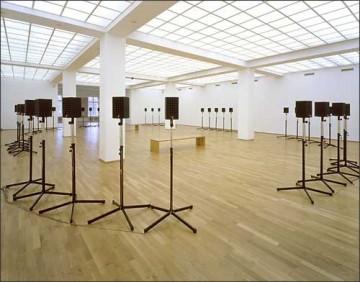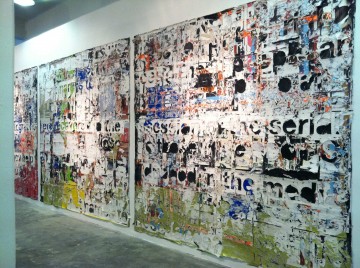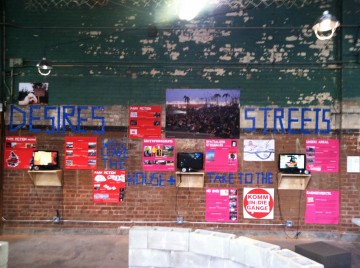Recently, I visited three shows– September 11, Untitled (12th Istanbul Biennale), and Creative Time’s Living As Form – all of which I highly recommend. The shows were a treasure trove in that they presented three distinct ways of curating art that reference the world around us, and offer ways to navigate that world. I’m categorizing these three different exhibition types as poetry, prose, and pamphlet.
Poetry
September 11 at MoMA’s PS1 is gorgeous, elegiac poetry. Marking the tenth anniversary of the US attacks, it shows, by way of almost 70 works, how our perception of the world–and correspondingly, how we look at artworks –has changed as a result of what happened on September 11, 2001. Walking through the exhibition, I couldn’t help but think how different the world would be if the United States’s response at the time would have had more of the tone, mood, and contemplation that is present in the show. Only one work was made after the attacks: Ellsworth Kelly’s Ground Zero, 2003, an abstract green field hovering above an image of Ground Zero that was printed in the New York Times. Yet Kelly’s abstraction is the frame through which curator Peter Eleey evokes a way of thinking about the present, past, and future as a result of 9/11.
Beautifully installed, the exhibition has a meditative resonance that is both open-ended and disarmingly sad. Much has been said about the central room that contains Roger Hiorns’s ash from the remains of an airplane engine splayed on the floor, in the middle of George Segal’s woman sitting on a park bench, and Harold Mendez’s empty bulletin boards. (Full disclosure: I own one of the bulletin boards by Mendez, a Chicago artist–bought with money I didn’t spend on a cell phone). Emblematic of the power of those associations that resonate throughout the show, it offers an individual witness to the trauma and a sense of resulting emptiness that hovers over the show. Upstairs, Eleey installed Janet Cardiff’s transcendent The Forty Part Motet, forty speakers arranged in a large circle at human height, which allows the viewer an intimate engagement with each of forty separate voices. Eleey placed the work in the same space it was immediately after the attacks, and has said about the work: “The particular combination of the individual voice and the collective song for me, and I think for many people, evoked the many personal effects of the tragedy and their sublimation into national tragedy.”

Janet Cardiff. "Forty-Part Motet," 2001. Installation view of work as it was presented at The Tate Liverpool; lent by Pamela and Richard Kramlich and the American Fund for the Tate Gallery, fractional and promised gift, 2000.
Prose
Also curated from a particular reference point is The 12th Istanbul Biennale, which draws on five of Felix Gonzalez-Torres’s works and their corresponding politics. These become the themes–the modernist grid, the body, national identity, history, and violence –for the corresponding set of group exhibitions and solo exhibitions. Like Kelly’s abstraction, Gonzalez-Torres’s concerns become the lens through which curators Jens Hoffman and Adriano Pedrosa, as they write in the comprehensive exhibition catalogue, “reassess how politics and aesthetics are articulated in contemporary art and represented in exhibitions.” The show’s thoughtful organization and tightly presented architectural and conceptual layout has received favorable coverage in the press. This is interesting, since this seems to help the Western press to digest the Biennale, as it highlights the work of lesser-known Latin American, Eastern European, and Middle Eastern artists, who presented complex and political readings of themes not easily legible to those living in the West.
The show is filled with formally beautiful and evocative works, such as Zarina Hashmi’s gold leaf Blinding Light, 2010; Zarouhie Abdalian’s sound installation Having been held under the sway, 2011; as well as much more literal yet powerful works such as Hank Willis Thomas’s I Am A Man, 2009, from the series I Am, Amen; Mona Vatamanu and Florin Tudor’s VHS Land Distribution, which reflected Venezuelans marking land through VHS tape; and the Ardmore Ceramic Art Studio’s Spread of Aids/HIV, 2002 and The Nation, Or Life, 2001, through which animals such as monkeys or frogs (considered to be evil witches) broke through South Africa’s silence surrounding HIV and AIDS.
The most well-known artist is Mark Bradford, who has created probably the least literal work in the show– a painting titled Rat Catcher of Hamelin, 2011, drawn from fifty billboards that were created in an effort to apprehend a notorious serial killer in Los Angeles. While the work discusses the killer’s violence, it also exposes the exploitation of the billboard and website campaign, which included the victims’ images. Hugely entertaining to the public is Wael Shawky’s gruesome Cabaret Crusades: The Horror Show File, a film in which marionettes are used to re-interpret four years of the Crusades. Also included in this section’s exhibition is Kris Martin’s Obussen II. A year ago, when I first discovered Martin’s repurposed howitzer shell vases, they seemed infused with a transcendent power. However, when placed within a room whose subjects included death, killing, and guns, the work’s inclusion in the show seemed too much of a forced, closed reading. This seems at odds with Gonzales Torres’s more opaque allusions to violence , although Martin’s heap could also be interpreted in terms of the tragic waste and loss of war.

Mark Bradford. "Rat-Catcher of Hamelin," 2011.Courtesy the artist and Sikkema Jenkins and Co., New York, USA. Photo by Tricia Van Eck.
Pamphlet
Nato Thompson, who curated Living As Form for Creative Time, writes in his curatorial statement that the artists, collectives, and organizations that he and twenty-five other curators presented “illustrate that the skill sets of art are now among a series of complex social organizational methods meant to transform our world.” The commissioned works, he continues, “were chosen for their energy, not the notion of art, which propels them toward the elusive goal of social justice.” The exhibition presented a twenty-five year survey of over 100 international, socially engaged projects, as well as new commissions and an excellent online social practice archive. I love handouts, artists’ books, pamphlets, post cards, petitions, etc., so there was plenty for me to fill my bag with swag. Chicago’s Temporary Services had an excellent Market, which brought together an impressive host of individuals, organizations, and business from the Lower East Side to operate stalls as ways of investigating the intersections between art, labor, economics, and social experiences. Jim’s Pepper Roaster offered tasty free samples and had a list of items for sale that included “free salad.” (I asked how much the free salad was and was excitedly told, “It’s free!”). All of the projects were presented through artifacts, handouts, videos or photographs and well-written accompanying texts.
The most hopeful project–and this was difficult to chose, since so many were inspirational–was Park Fiction, part of the Right to the City Network Hamburg which, through picnicking and pretending that a public area in St. Pauli, Hamburg was going to be turned into a park, rather than be sold to a developer, eventually did transform the public area into a park. I especially liked their planning tools: the Archive of Desires, the Garden Library, and Action Kit (a portable planning studio for house visits). I also went on the “Underground Service Alert” walking tour led by Damon Rich, who discussed the competing power relationships that, over time, have shaped the area around the exhibition called the Seward Park Urban Renewal Area. Having recently been part of Occupy Wall Street, this was fascinating for me to see because it cleverly presented, through speaking parts offered to my fellow walkers, the ways in which competing voices argue for change. Some of the roles were that of developers, Jewish intellectuals, members of New York City’s Economic Development Corporation, and union laborers.
Another site we visited was a garment workers’ union housing co-op. The price of units had been kept affordable until recently, when the co-op collectively decided to change the price of units to around $750,000. The co-op also wanted to remove some pro-labor murals from the building (because they thought they were outdated), but many of the new, younger owners argued they were too cool to remove. Ah, the power of the people! The strength of the Underground Service Alert walking tour, and of the other works in Living As Form, is that it revealed the everyday vicissitudes, realities, struggles, and lessons to be learned from sustained political engagement.





